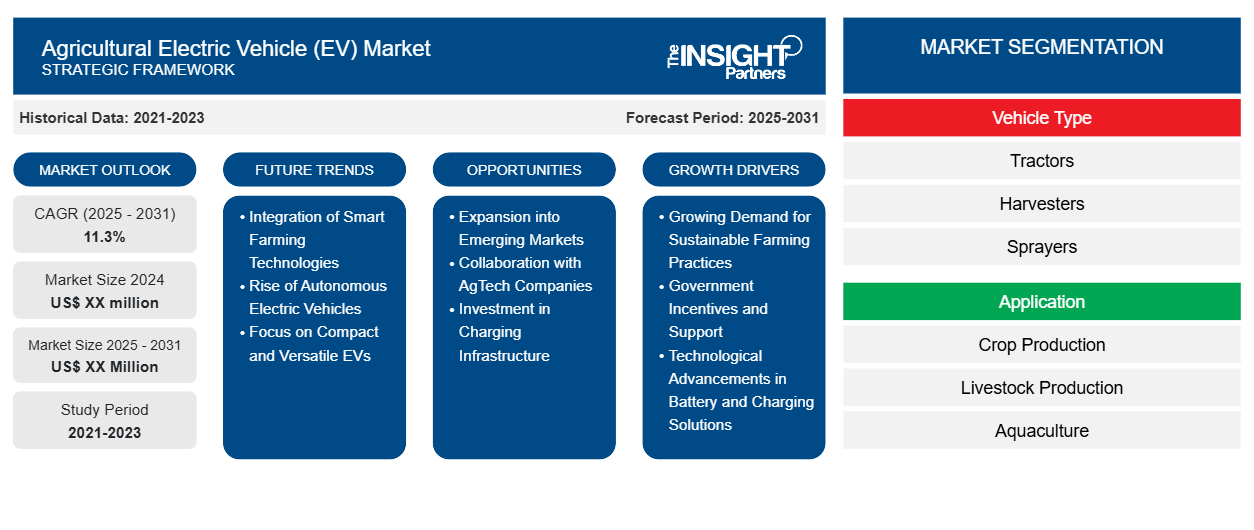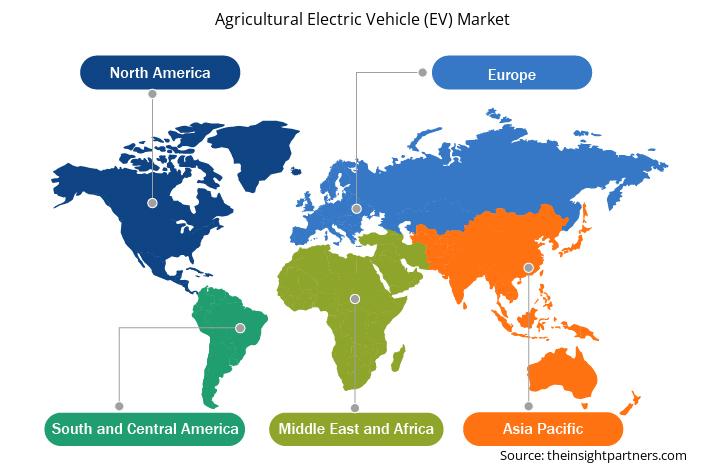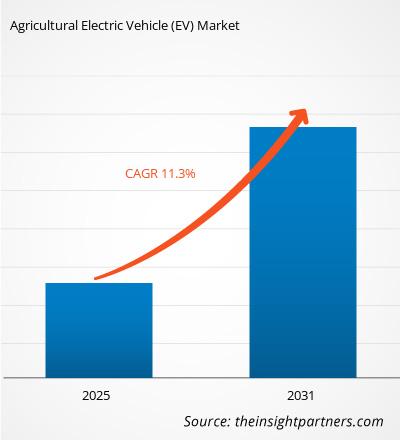농업용 전기 자동차(EV) 시장은 2025년부터 2031년까지 11.3%의 CAGR을 기록할 것으로 예상되며, 시장 규모는 2024년 XX백만 달러에서 2031년 XX백만 달러로 확대될 것입니다.
본 보고서는 차량 유형(트랙터, 수확기, 분무기), 적용 분야(작물 생산, 가축 생산, 양식업)별로 세분화되어 있습니다. 전 세계 분석은 지역 및 주요 국가별로 더욱 세분화되어 있습니다. 본 보고서는 위 분석 및 세그먼트에 대한 가치를 미국 달러(USD)로 제공합니다.
보고서의 목적
The Insight Partners의 농업용 전기 자동차(EV) 시장 보고서는 현재 상황과 미래 성장, 주요 추진 요인, 과제, 그리고 기회를 설명합니다. 이를 통해 다음과 같은 다양한 비즈니스 이해관계자들에게 통찰력을 제공할 수 있습니다.
- 기술 공급업체/제조업체: 변화하는 시장 역학을 이해하고 잠재적인 성장 기회를 파악하여 정보에 입각한 전략적 결정을 내릴 수 있도록 합니다.
- 투자자: 시장 성장률, 시장 재무 전망, 가치 사슬 전반에 존재하는 기회에 대한 포괄적인 추세 분석을 수행합니다.
- 규제 기관: 시장의 정책과 경찰 활동을 규제하여 남용을 최소화하고, 투자자의 신뢰와 확신을 유지하며, 시장의 성실성과 안정성을 옹호합니다.
농업용 전기 자동차(EV) 시장 세분화
차량 유형
- 트랙터
- 수확기
- 분무기
애플리케이션
- 작물 생산
- 가축 생산
- 양식업
귀하의 요구 사항에 맞게 이 보고서를 사용자 정의하세요
이 보고서의 일부 또는 국가 수준 분석, Excel 데이터 팩을 포함하여 모든 보고서에 대한 사용자 정의를 무료로 받을 수 있으며, 신생 기업 및 대학을 위한 훌륭한 혜택과 할인도 이용할 수 있습니다.
농업용 전기 자동차(EV) 시장: 전략적 통찰력

- 이 보고서에서 주요 시장 동향을 알아보세요.이 무료 샘플에는 시장 동향부터 추정치 및 예측까지 다양한 데이터 분석이 포함됩니다.
농업용 전기 자동차(EV) 시장 성장 동인
- 지속가능한 농업 관행에 대한 수요 증가:
농업 분야는 환경 문제를 해결하고 탄소 발자국을 줄이기 위해 지속가능한 농업 관행을 점차 도입하고 있습니다. 이러한 변화는 기존 디젤 동력 기계보다 더 깨끗하고 효율적인 대안을 제공하는 전기 자동차에 대한 수요를 촉진하고 있습니다. 농부들은 배출량 감소, 연료비 절감, 운영 효율성 향상 등 전기 자동차의 이점을 인지하고 있습니다. 지속가능성이 최우선 과제로 부각됨에 따라 농업용 전기 자동차에 대한 수요는 크게 증가할 것으로 예상됩니다.EVs in reducing emissions, lowering fuel costs, and enhancing operational efficiency. As sustainability becomes a priority, the demand for agricultural electric vehicles is expected to grow significantly. - 정부 인센티브 및 지원:
전 세계 여러 정부가 농업 분야를 포함하여 전기 자동차 도입을 장려하기 위한 정책을 시행하고 인센티브를 제공하고 있습니다. 이러한 인센티브에는 세금 환급, 보조금, 전기 농기계 구매 보조금 등이 포함될 수 있습니다. 또한, 정부는 농촌 지역의 전기 자동차 도입을 지원하기 위해 충전 인프라에 투자하고 있습니다. 이러한 지원 조치는 농부들이 전기 자동차에 더 쉽게 접근하고 경제적으로 실현 가능하게 하여 시장 성장을 더욱 촉진하고 있습니다.EV adoption in rural areas. Such supportive measures are making electric vehicles more accessible and financially viable for farmers, further propelling market growth. - 배터리 및 충전 솔루션의 기술 발전:
최근 배터리 기술과 충전 솔루션의 발전은 농업용 전기 자동차 시장에 큰 영향을 미치고 있습니다. 배터리 용량, 효율, 그리고 수명의 향상으로 전기 자동차는 더 오래 작동하고 더 먼 거리를 주행할 수 있게 되었습니다. 또한, 고속 충전소의 개발로 충전 시간이 단축되어 농업용 전기 자동차의 실용성이 더욱 높아졌습니다. 기술이 지속적으로 발전함에 따라 전기 자동차의 매력도가 높아지고 농업 현장에서의 도입이 촉진되고 있습니다.
농업용 전기자동차(EV) 시장 미래 동향
- 스마트 농업 기술 통합:
농업용 EV 시장은 스마트 농업 기술 통합 추세를 보이고 있습니다. 전기 자동차에는 첨단 센서, GPS, IoT 연결 기능이 탑재되어 농업 운영을 최적화하는 추세가 점차 커지고 있습니다. 이러한 통합을 통해 정밀 농업이 가능해져 농부는 작물, 토양 상태, 기계 성능을 실시간으로 모니터링할 수 있습니다. 스마트 농업이 보편화됨에 따라 이러한 기술을 지원하는 전기 자동차에 대한 수요가 증가하여 시장 혁신을 촉진할 것으로 예상됩니다. - 자율주행 전기차의 부상:
또 다른 주목할 만한 추세는 농업 분야에서 자율주행 전기차의 부상입니다. 이러한 자율주행 기계는 파종, 수확, 밭 모니터링 등 다양한 작업을 사람의 직접적인 개입 없이 수행할 수 있습니다. 전력과 자동화의 결합은 효율성을 높일 뿐만 아니라 인건비도 절감합니다. 농부들이 생산성 향상과 운영 효율화를 모색함에 따라 자율주행 전기차에 대한 관심이 높아지고 있으며, 이는 농업의 미래를 형성하는 데 중요한 역할을 할 것입니다. - 소형 및 다용도 전기차에 집중:
좁은 밭을 누비고 다양한 농업 환경에서 작업할 수 있는 소형 및 다용도 전기차에 대한 수요가 증가하고 있습니다. 농부들은 친환경적일 뿐만 아니라 운송부터 밭 작업까지 다양한 작업을 수행할 수 있는 차량을 찾고 있습니다. 이러한 추세에 따라 제조업체들은 현대 농업의 다양한 요구를 충족할 수 있는 더 작고 민첩한 전기차를 개발하여 시장에서의 입지를 강화하고 있습니다.
농업용 전기 자동차(EV) 시장 기회
- 신흥 시장 진출:
신흥 시장은 농업용 전기 자동차 시장에 중요한 기회를 제공합니다. 이 지역들이 급속한 도시화와 농업 현대화를 경험함에 따라 효율적인 농업 솔루션에 대한 수요가 증가하고 있습니다. 전기 자동차는 생산성을 향상시키고 환경에 미치는 영향을 최소화하는 데 중요한 역할을 할 수 있습니다. 이러한 시장에 전략적으로 진출하는 기업은 지속 가능한 농업 방식에 대한 증가하는 수요를 활용하여 장기적인 성장과 성공을 위한 입지를 구축할 수 있습니다. - AgTech 기업과의 협력:
전기차 제조업체와 AgTech 기업 간의 협력은 제품 제공을 향상시킬 수 있는 특별한 기회를 제공합니다. 기술 기업과의 협력을 통해 제조업체는 정밀 농업 도구, 데이터 분석, 원격 모니터링 시스템 등의 혁신적인 솔루션을 전기차에 통합할 수 있습니다. 이러한 협력은 더욱 정교하고 효율적인 농업 솔루션 개발로 이어져, 운영 최적화를 위한 포괄적인 도구를 찾는 기술에 정통한 농부들에게 어필할 수 있습니다. - 충전 인프라 투자:
견고한 충전 인프라 구축은 농업용 전기 자동차 시장에 중요한 기회입니다. 전기 자동차의 수가 증가함에 따라 안정적이고 접근성이 뛰어난 충전소에 대한 수요도 증가할 것입니다. 기업과 정부는 농촌 및 농업 지역에 특화된 충전 네트워크 구축에 투자하여 농부들이 전기 자동차 도입에 필요한 지원을 받을 수 있도록 할 수 있습니다. 이러한 인프라 투자는 농업 분야에서 전기 자동차의 활용 가능성을 크게 높여 더 광범위한 도입을 촉진할 수 있습니다.
농업용 전기 자동차(EV) 시장 지역별 통찰력
Insight Partners의 분석가들은 예측 기간 동안 농업용 전기 자동차(EV) 시장에 영향을 미치는 지역별 동향과 요인을 면밀히 분석했습니다. 이 섹션에서는 북미, 유럽, 아시아 태평양, 중동 및 아프리카, 그리고 중남미 지역의 농업용 전기 자동차(EV) 시장 부문 및 지역별 현황도 살펴봅니다.

- 농업용 전기자동차(EV) 시장에 대한 지역별 데이터를 얻으세요
농업용 전기 자동차(EV) 시장 보고서 범위
| 보고서 속성 | 세부 |
|---|---|
| 2024년 시장 규모 | 미화 XX백만 달러 |
| 2031년까지 시장 규모 | 미화 XX백만 달러 |
| 글로벌 CAGR(2025~2031년) | 11.3% |
| 역사적 데이터 | 2021-2023 |
| 예측 기간 | 2025-2031 |
| 다루는 세그먼트 | 차량 유형별
|
| 포함된 지역 및 국가 | 북아메리카
|
| 시장 선도 기업 및 주요 회사 프로필 |
|
농업용 전기 자동차(EV) 시장 참여자 밀도: 비즈니스 역학에 미치는 영향 이해
농업용 전기 자동차(EV) 시장은 소비자 선호도 변화, 기술 발전, 그리고 제품 이점에 대한 인식 제고 등의 요인으로 최종 사용자 수요가 증가함에 따라 빠르게 성장하고 있습니다. 수요가 증가함에 따라 기업들은 제품 라인업을 확장하고, 소비자 니즈를 충족하기 위한 혁신을 추진하며, 새로운 트렌드를 적극 활용하고 있으며, 이는 시장 성장을 더욱 가속화하고 있습니다.
시장 참여자 밀도는 특정 시장이나 산업 내에서 활동하는 기업들의 분포를 나타냅니다. 이는 특정 시장 공간에 얼마나 많은 경쟁자(시장 참여자)가 존재하는지를 규모나 전체 시장 가치 대비로 나타냅니다.
농업용 전기 자동차(EV) 시장에서 운영되는 주요 회사는 다음과 같습니다.
- 마힌드라 & 마힌드라
- 얀마
- 솔리스
- 키오티 트랙터
- 줌리온
면책 조항 : 위에 나열된 회사는 특정 순서에 따라 순위가 매겨지지 않았습니다.

- 농업용 전기 자동차(EV) 시장의 주요 기업 개요를 알아보세요
주요 판매 포인트
- 포괄적인 범위: 이 보고서는 농업용 전기 자동차(EV) 시장의 제품, 서비스, 유형 및 최종 사용자에 대한 분석을 포괄적으로 다루어 전체적인 상황을 제공합니다.
- 전문가 분석: 이 보고서는 업계 전문가와 분석가의 심층적인 이해를 바탕으로 작성되었습니다.
- 최신 정보: 이 보고서는 최신 정보와 데이터 동향을 다루므로 비즈니스 관련성이 보장됩니다.
- 사용자 정의 옵션: 이 보고서는 특정 클라이언트 요구 사항에 맞게 사용자 정의하여 비즈니스 전략에 적합하게 만들 수 있습니다.
따라서 농업용 전기 자동차(EV) 시장 연구 보고서는 산업 상황과 성장 전망을 분석하고 이해하는 데 앞장서는 데 도움이 될 수 있습니다. 몇 가지 우려 사항이 있을 수 있지만, 이 보고서의 전반적인 장점은 단점보다 훨씬 큰 것으로 보입니다.
- 과거 분석(2년), 기준 연도, CAGR을 포함한 예측(7년)
- PEST 및 SWOT 분석
- 시장 규모 가치/거래량 - 글로벌, 지역, 국가
- 산업 및 경쟁 환경
- Excel 데이터세트
최근 보고서
사용 후기
구매 이유
- 정보에 기반한 의사 결정
- 시장 역학 이해
- 경쟁 분석
- 고객 인사이트
- 시장 예측
- 위험 완화
- 전략 기획
- 투자 타당성 분석
- 신흥 시장 파악
- 마케팅 전략 강화
- 운영 효율성 향상
- 규제 동향에 발맞춰 대응




















 무료 샘플 받기 - 농업용 전기자동차(EV) 시장
무료 샘플 받기 - 농업용 전기자동차(EV) 시장